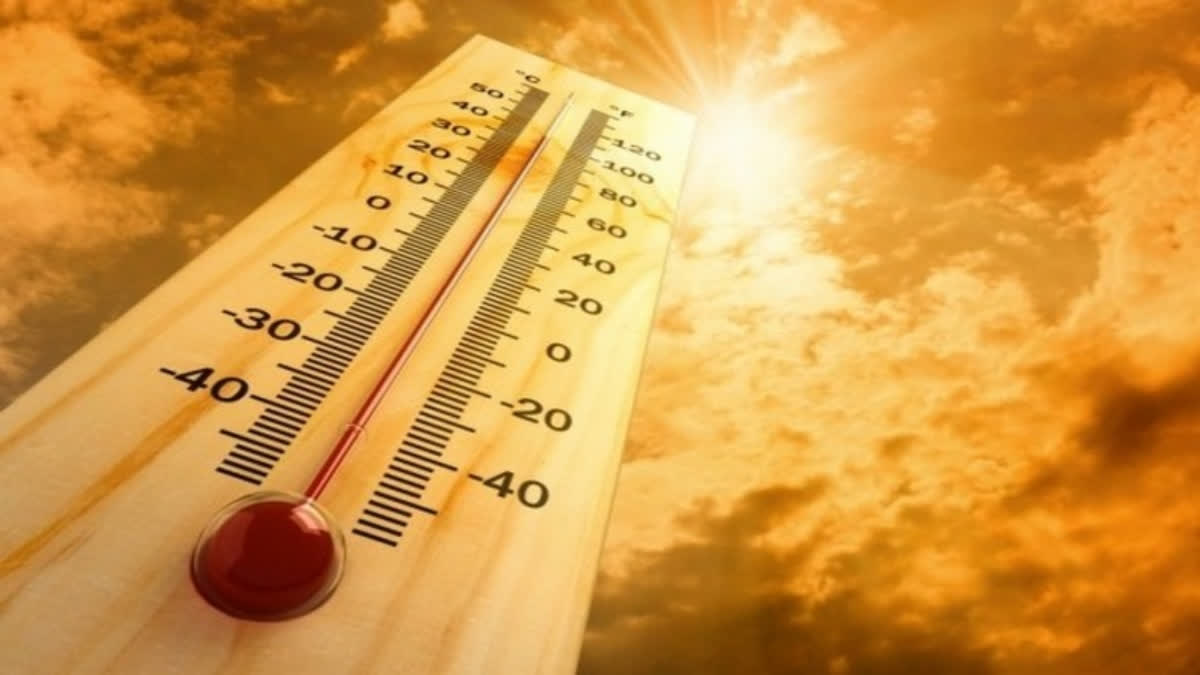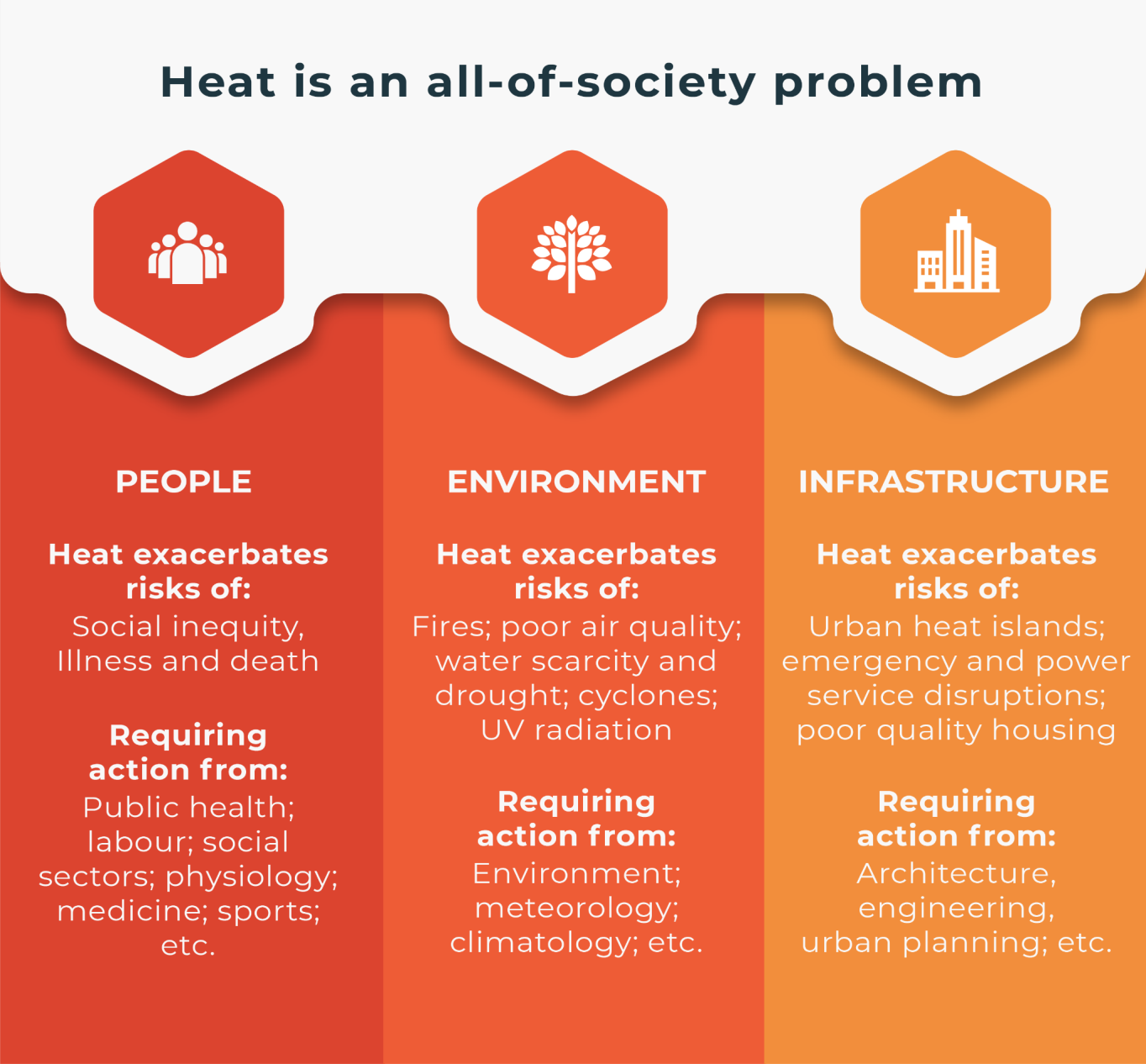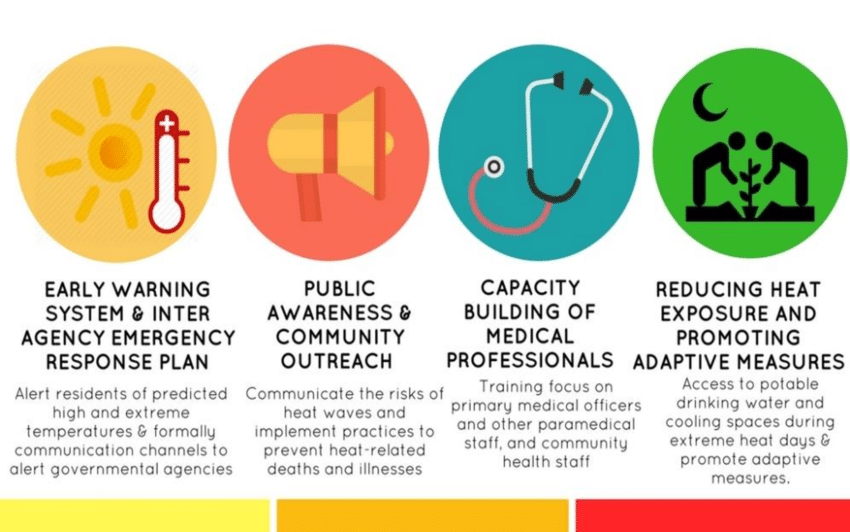Description

Copyright infringement not intended
Picture Courtesy: https://www.etvbharat.com/english/state/delhi/delhis-heat-action-plan-ready-say-officials/na20230619204201599599710
Context: Heat action plans (HAPs) in India focus on mitigating heat wave impacts through forecasts, education, shelters, and healthcare readiness.
About Heat Waves
- The India Meteorological Department (IMD) classifies heat waves based on geographical location.
- In the plains, a heatwave is declared when the maximum temperature reaches 40°C or more.
- For coastal areas, it's 37°C or more.
- In hilly regions, it's 30°C or more.
- The severity of a heatwave is determined by the difference (departure) from the normal temperature for that location and time of year. A "normal" heatwave has a departure of 4.5-6.4°C, while a "severe" heatwave has an even higher departure.
- The IMD also uses a definition based on absolute maximum temperature. A heatwave is declared when the maximum temperature exceeds 45°C, and a severe heatwave is when it surpasses 47°C. However, this applies only if at least two stations in a region report such high temperatures or if one station experiences this extreme for two consecutive days.

Heat Action Plans (HAPs)
- Governments at various levels in India have developed Heat Action Plans (HAPs) to enhance preparedness and mitigate the adverse impacts of extreme heat. These plans outline strategies and measures to be undertaken before, during, and after heatwave events.
Components of HAPs
- Heatwave Forecasting and Early Warning Systems: Utilising meteorological data to forecast and alert the public about impending heatwaves.
- Public Awareness Campaigns: Educating communities about heatwave risks and precautionary measures.
- Establishment of Heat Shelters and Cooling Centers: Providing safe spaces with cooling facilities during heatwaves.
- Ensuring Adequate Healthcare Infrastructure: Hospitals equipped with necessary supplies and trained staff to manage heat-related illnesses.
Long-term Measures
- Urban Planning Strategies: Strategies may involve planting trees to create shade and promoting the use of heat-resistant building materials. This helps reduce the "urban heat island effect," where cities experience higher temperatures than surrounding areas due to the abundance of heat-absorbing surfaces.
- Nature-based Solutions: Incorporating green spaces, such as woods, meadows and parks, or blue spaces such as rivers, lakes and seas to mitigate extreme heat in urban areas.
- Cool Roofs: Technologies like cool roofs that reflect sunlight and absorb less heat can be implemented to lower indoor temperatures in buildings.

While HAPs represent a positive step, several limitations hinder their effectiveness:
Local Variations
- The national heatwave thresholds set by the IMD might not capture the full picture.
- Factors like humidity, the urban heat island effect, and access to water bodies significantly influence how people experience heat. HAPs need to consider these regional variations and modify interventions accordingly.
Inconsistent Methods
- Currently, vulnerability assessments conducted during HAP development lack consistency.
- A more robust and comprehensive climate risk assessment is needed. This should identify areas most susceptible to heatwaves, estimate the potential impact on people and infrastructure, and account for existing vulnerabilities.
- Hotspot mapping can help prioritise interventions in the most critical areas.
Vulnerable Populations
- HAPs prioritise protecting vulnerable groups like children, the elderly, and low-income communities. However, they often lack targeted interventions that address the specific needs of these populations based on their socio-economic background and surrounding infrastructure.
- Over 90% of India's workforce is informal, with many working outdoors throughout the day. HAPs need to acknowledge the challenges faced by these workers and formulate strategies that allow them to stay safe during heat waves without losing income.
Resource Allocation
- The implementation of HAPs heavily depends on the resources and priorities of local governments. Dedicated budgets and financial plans are crucial for effective implementation, especially regarding support for informal workers during heatwaves.
Limited Scope
- HAPs mainly focus on building infrastructure like cool roofs. However, they often neglect "nature-based solutions" like incorporating green spaces (parks, gardens) and blue spaces (water bodies) in urban planning. These elements can significantly reduce ambient temperatures and provide natural cooling.
Way forward for effectively addressing Heatwaves
Enhanced Localised Approaches
- Localised Heat Wave Definitions: Develop and implement comprehensive heatwave definitions that consider local factors such as urban heat island effect, humidity levels, and proximity to water bodies. This will ensure an accurate assessment of heatwave severity and appropriate response measures.
- Climate Risk Assessments: Conduct robust climate risk assessments at localised levels to identify areas prone to heatwaves and vulnerable populations. Use standardised methodologies to assess exposure, sensitivity, and adaptive capacity to extreme heat.
- Tailored Interventions: Design targeted interventions based on local socio-economic contexts and infrastructure conditions. Prioritise vulnerable populations such as low-income communities, children, and the elderly in heat resilience strategies.
Improved Resource Allocation and Integration
- Dedicated Budgets: Allocate dedicated financial resources for implementing Heat Action Plans (HAPs) at state, district, and city levels. Ensure sufficient funding for heat shelters, early warning systems, public awareness campaigns, and healthcare infrastructure.
- Stakeholder Coordination: Foster collaboration and coordination among government agencies, civil society organisations, healthcare providers, community groups, and emergency services. Establish partnerships to leverage resources and expertise for effective heat resilience measures.
- Integration with Climate Adaptation Plans: Integrate HAPs with broader urban resilience and climate adaptation strategies. Align heat resilience measures with urban planning initiatives, green infrastructure development, and disaster risk reduction efforts.
Focus on Nature-based Solutions
- Green Infrastructure: Promote nature-based solutions such as urban green spaces, parks, and tree planting to mitigate the urban heat island effect. Enhance canopy cover and vegetation to provide natural cooling and shade in urban areas.
- Cool Roofing Technologies: Encourage the use of cool roofing materials and reflective surfaces to reduce solar absorption and lower indoor temperatures. Implement building codes that prioritize heat-resilient construction practices.
Capacity Building and Public Engagement
- Community Education: Conduct public awareness campaigns to educate communities about heatwave risks, symptoms of heat-related illnesses, and precautionary measures. Encourage behavioural changes to reduce heat exposure during extreme weather events.
- Capacity Building: Provide training and capacity building for healthcare professionals, emergency responders, and local authorities on heatwave management and response protocols. Ensure healthcare facilities are equipped to handle heat-related illnesses and emergencies.
Monitoring and Evaluation
- Data Collection and Monitoring: Improve data collection and monitoring systems to assess the effectiveness of HAPs over time. Implement heatwave tracking mechanisms to monitor temperature trends, heat-related health impacts, and community resilience indicators.
- Adaptive Management: Continuously evaluate and update HAPs based on lessons learned and evolving climate conditions. Adopt adaptive management strategies to enhance the resilience and responsiveness of heat resilience measures.
Policy Support and Advocacy
- Policy Integration: Advocate for the integration of heat resilience considerations into national and regional policies, including urban planning, public health, and disaster management frameworks. Ensure policy coherence and alignment with climate adaptation goals.
- Partnerships and Advocacy: Build partnerships with academia, research institutions, and international organisations to advance heat resilience research, innovation, and advocacy. Collaborate on policy dialogues and knowledge-sharing initiatives to promote best practices.
Conclusion
- Addressing heatwaves in India requires a holistic approach that combines localised strategies, improved resource allocation, nature-based solutions, community engagement, and policy support. By strengthening Heat Action Plans (HAPs) with targeted interventions, enhanced stakeholder coordination, and a focus on adaptive management, India can build resilience to extreme heat events and protect vulnerable populations from the impacts of climate change.
Must Read Articles:
Heat Waves
Heat Waves in Different Parts of The World
Source:
The Hindu
|
PRACTICE QUESTION
Q. Heat waves disproportionately impact certain populations. How can a heat wave action plan effectively identify and address the needs of vulnerable groups, such as the elderly, homeless individuals, or those living in poverty, who may have limited access to cooling centres or resources?
|












